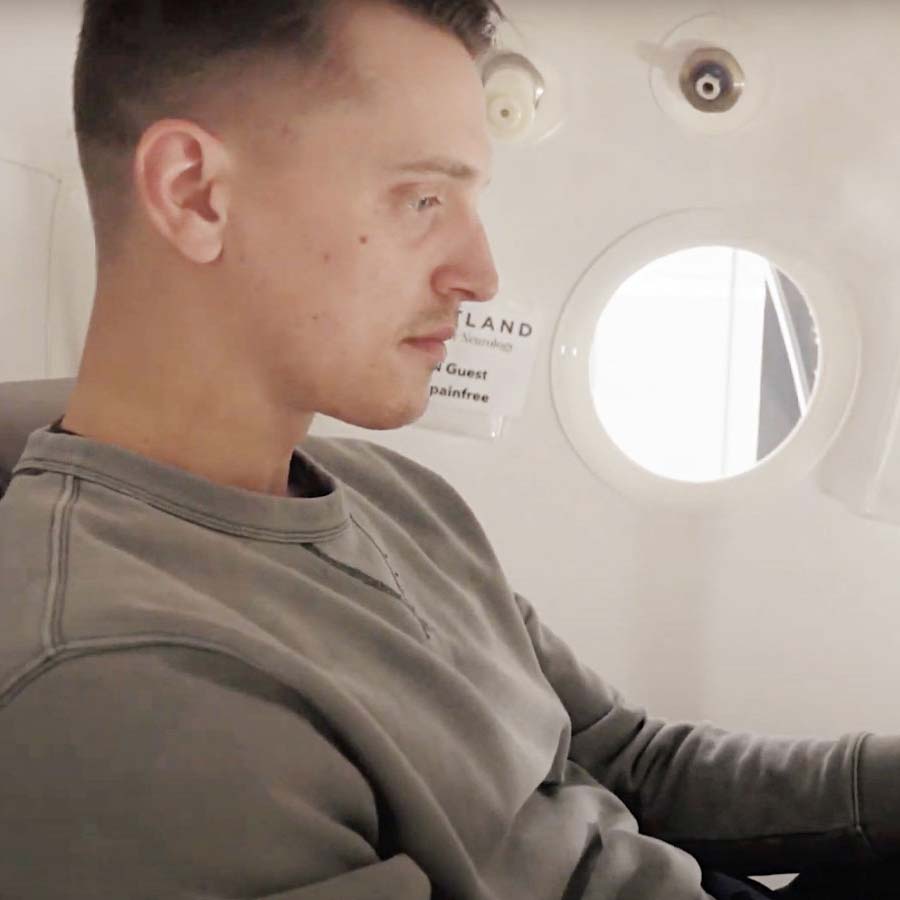Concussion / Traumatic Brain Injury / Post-concussion syndrome
Hyperbaric oxygen therapy shows substantial benefit for treatment of Concussion/TBI and Post-concussion syndrome in both children and adults, even years after injury. Concussion/TBI may create long-term neuroplastic changes that affect cognitive and brain stem microstructure and functionality. Symptoms often include dizziness, vertigo, visual tracking errors, inability to focus/read/scroll, diplopia (double vision), orthostatic intolerance (dizziness upon standing), autonomic dysregulation, brain fog, headaches, migraines, balance issues, neck and body pain, emotional dysregulation (anxiety/depression/frustration), sleep quality changes, digestive changes, and sexual dysfunction. HBOT is extremely helpful in acute or chronic brain injuries through its ability to restore microstructural integrity of neural pathway and neuron health by improving plasma oxygen levels up to 1200% to supersaturate brain tissue with energy that restores cellular function, induce neuroplasticity, reduce neuro-inflammation, promote cerebral angiogenesis, activate stem cells up to 800%, modulate immune function, and repair autonomic dysregulation.
Hyperbaric oxygen therapy in children with post-concussion syndrome improves cognitive and behavioral function: a randomized controlled trial https://pubmed.ncbi.nlm.nih.gov/36151105/
“Clinical outcomes correlated with significant improvements in brain MRI microstructural changes in the insula, supramarginal, lingual, inferior frontal and fusiform gyri. The study suggests that HBOT improves both cognitive and behavioral function, PPCS symptoms, and quality of life in pediatric PPCS patients at the chronic stage, even years after injury.”
Hyperbaric oxygen may induce angiogenesis in patients suffering from prolonged post-concussion syndrome due to traumatic brain injury https://pubmed.ncbi.nlm.nih.gov/26484702/
“……HBOT may induce cerebral angiogenesis, which improves perfusion to the chronic damage brain tissue even months to years after the injury.”
Hyperbaric Oxygen Therapy Can Induce Angiogenesis and Regeneration of Nerve Fibers in Traumatic Brain Injury Patients https://pubmed.ncbi.nlm.nih.gov/29097988/
“…… HBOT can induce cerebral angiogenesis and improve both white and gray microstructures indicating regeneration of nerve fibers. The micro structural changes correlate with the neurocognitive improvements.”
Hyperbaric oxygen therapy can improve post concussion syndrome years after mild traumatic brain injury – randomized prospective trial https://pubmed.ncbi.nlm.nih.gov/24260334/
“….HBOT can induce neuroplasticity leading to repair of chronically impaired brain functions and improved quality of life in mTBI patients with prolonged PCS at late chronic stage.”
Hippocampal cerebral blood flow increased following low-pressure hyperbaric oxygenation in firefighters with mild traumatic brain injury and emotional distress https://pubmed.ncbi.nlm.nih.gov/33532950/
“The current study demonstrated that low-pressure HBOT might increase rCBF of the hippocampal and parahippocampal regions, suggesting a potential underpinning mechanism of HBOT in the human brain.”
Hyperbaric oxygen: B-level evidence in mild traumatic brain injury clinical trials https://pubmed.ncbi.nlm.nih.gov/27581219/
Hyperbaric oxygen therapy for mild traumatic brain injury persistent postconcussion syndrome: a randomized controlled trial https://pubmed.ncbi.nlm.nih.gov/32189664/
“…..statistically significant improvements in postconcussion and Post-Traumatic Stress Disorder symptoms, memory, cognitive functions, depression, anxiety, sleep, and quality of life in civilian and military subjects with mTBI/PPCS compared to controls. Improvements persisted at least 2 months after the 40th HBOT.”
Hyperbaric oxygen therapy compared to pharmacological intervention in fibromyalgia patients following traumatic brain injury: A randomized, controlled trial https://pubmed.ncbi.nlm.nih.gov/36897850/
“Hyperbaric oxygen and hyperbaric air have demonstrated therapeutic effects on mTBI/PPCS symptoms and can alleviate posttraumatic stress disorder symptoms secondary to a brain injury in 5 out of 5 peer-reviewed clinical trials.”
Effect of hyperbaric oxygen therapy on chronic neurocognitive deficits of post-traumatic brain injury patients: retrospective analysis https://pubmed.ncbi.nlm.nih.gov/30269074/
“……In the largest published cohort of patients suffering from chronic deficits post-TBI of all severities, HBOT was associated with significant cognitive improvements. The clinical improvements were well correlated with increased activity in the relevant brain areas.”
“….The perirhinal cortex activation after HBOT was most prominent in patients who had significant memory improvement. The perirhinal cortex has a critical role in object recognition memory while interacting with the hippocampus.”
“….The prefrontal cortex.. and more specifically, the inferior frontal gyrus activations after HBOT were prominent in all patients with significant executive function improvements. The right frontal gyrus is known to mediate a go/no go task, which was among the executive function tests used in the present study. The prefrontal gyrus is presumed to act as a filtering system that enhances goal directed activities and inhibits irrelevant activations. This filtering mechanism enables executive control.”
“….The anterior cingulate gyrus activation after HBOT was seen in the subjects with attention improvement. The anterior cingulate gyrus is presumed to be involved in error detection, especially in a Stroop task, which was used in the attention tests. Lesions in this area can cause inattention to akinetic mutism.”
Hyperbaric Oxygen Therapy for the Management of Mild and Moderate Traumatic Brain Injury: A Single-Center Experience https://pubmed.ncbi.nlm.nih.gov/37244521/
A phase I study of low-pressure hyperbaric oxygen therapy for blast-induced post-concussion syndrome and post-traumatic stress disorder https://pubmed.ncbi.nlm.nih.gov/22026588/
“…Forty 1.5 ATA HBOT sessions in 1 month was safe in a military cohort with chronic blast-induced PCS and PTSD. Significant improvements occurred in symptoms, abnormal physical exam findings, cognitive testing, and quality-of-life measurements, with concomitant significant improvements in SPECT.”
